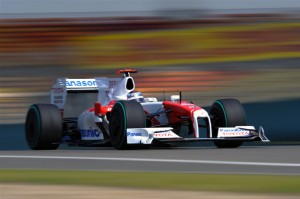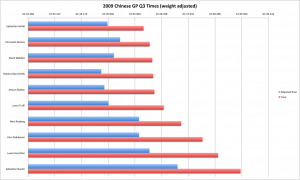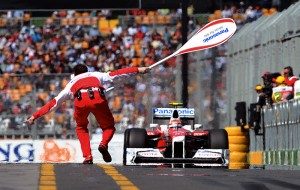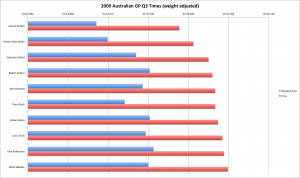 Once again the established order is upset and and an exciting qualifying session in Shanghai ended with Sebastian Vettel putting in a blinding lap to take pole position for Red Bull. Fernando Alonso also surprised by putting his Renault alongside him on the front row.
Once again the established order is upset and and an exciting qualifying session in Shanghai ended with Sebastian Vettel putting in a blinding lap to take pole position for Red Bull. Fernando Alonso also surprised by putting his Renault alongside him on the front row.
But were those times really indicative of race pace or were their cars fueled light?
Well, thanks to the FIA now publishing the weights of all cars after qualifying we can figure it out for ourselves. Below is a graph showing the actual lap times of the cars compared to their fuel-adjusted lap times. Only the top ten are shown because any car that doesn’t make it into the third qualifying session may refuel before the race.

We can see from the graph that the two Brawn GP cars are still fastest and Alonso and the two Red Bulls are fueled pretty light, although Vettel isn’t looking too bad. Jarni Trulli could also be a threat if he gets a good start from the third row.
 The FIA now publish the starting weights of the cars after qualifying. This has both an upside and a downside. You can now tell the fuel level of each car and therefore get a better idea of overall pace but, conversely, this removes some of the speculation and uncertainty over when a car will have to pit. Sometimes not knowing whether a car has enough fuel to stay out longer than another is part of the fun.
The FIA now publish the starting weights of the cars after qualifying. This has both an upside and a downside. You can now tell the fuel level of each car and therefore get a better idea of overall pace but, conversely, this removes some of the speculation and uncertainty over when a car will have to pit. Sometimes not knowing whether a car has enough fuel to stay out longer than another is part of the fun.
Either way, the data is now published and so there’s not much point in avoiding it. I figure we may as well take the good points and see if we can use it to get a better picture of how the cars will perform on race day.
By looking at the weights published we can tell how many kilograms of fuel each car is carrying. The minimum weight for a Formula One car is 605kg including the driver. The cars themselves are in fact lighter than this and so ballast is used to add weight to the car in the most advantageous way. This is where heavier drivers like Robert Kubica are disadvantaged; add in the extra 35kg for a KERS device and there is not much left for ballast. This is why Kubica is not running KERS in Melbourne like his smaller, lighter team mate. Every 10kg of fuel is worth on average about 0.3 seconds per lap.
So with that in mind I have put my nerd cap on and plugged the numbers into Excel. Below is a graph showing the actual lap times of the cars compared to fuel-adjusted lap times.

The cars that made it to Q3 are weighed after qualifying whereas those that were eliminated earlier may refuel before the race. We can see from the graph above that the Brawn cars were not running light and their weight-adjusted times are still faster than everyone else. Timo Glock is the quickest of the rest but he will have his work cut out for him starting at the back of the grid.
 Once again the established order is upset and and an exciting qualifying session in Shanghai ended with Sebastian Vettel putting in a blinding lap to take pole position for Red Bull. Fernando Alonso also surprised by putting his Renault alongside him on the front row.
Once again the established order is upset and and an exciting qualifying session in Shanghai ended with Sebastian Vettel putting in a blinding lap to take pole position for Red Bull. Fernando Alonso also surprised by putting his Renault alongside him on the front row.
 The FIA now publish the starting weights of the cars after qualifying. This has both an upside and a downside. You can now tell the fuel level of each car and therefore get a better idea of overall pace but, conversely, this removes some of the speculation and uncertainty over when a car will have to pit. Sometimes not knowing whether a car has enough fuel to stay out longer than another is part of the fun.
The FIA now publish the starting weights of the cars after qualifying. This has both an upside and a downside. You can now tell the fuel level of each car and therefore get a better idea of overall pace but, conversely, this removes some of the speculation and uncertainty over when a car will have to pit. Sometimes not knowing whether a car has enough fuel to stay out longer than another is part of the fun.